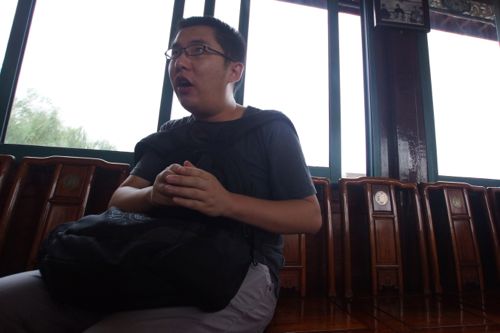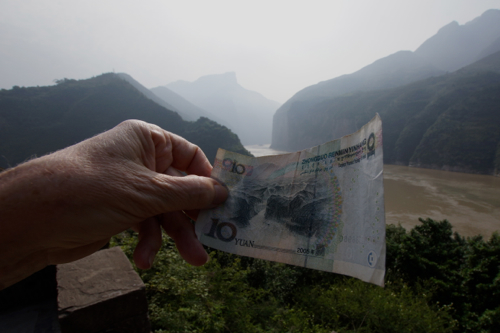Again shooting with the slightly malfunctioning Alpha 65 with the wide angle lens, and supported by the small RX100, we headed of to explore Hangzhou.
Our guide there was David. His mother is a philosopher and this was evident in his approach to life and the way in which he showed us around Hangzhou, his hometown.
As he explained to us, in questioning the meaning of existence, philosophers always look to the opposite side, never taking anything for granted. When things are good they look to see what bad things are just around the corner and then when things are bad they look to find the good.
David was a student of history, both ancient and modern. He was cynical about people’s motives throughout history and had many interesting stories to illustrate his cynicism.
From what we have seen so far, China is a prosperous, vibrant and ever expanding country. David didn’t share our optimism and believes that the country is on the verge of another revolution.
David explained to us that Hangzhou is the centre of software development in China. This isn’t writing original programs but rather hacking out vast amounts of code for software companies and even the big animation studios like Pixar.
Apparently there are tens of thousands of these ‘Digital Farmers’ working in the city. David was critical of this lack of originality and and the resulting exploitation.
On our first morning in Hangzhou we visited the Lingyin Temple, Six Harmonies Pagoda and the Dragon Well Tea Plantation.
The Lingyin Temple, originally founded in 328 AD, is a wealthy, large Buddhist temple with a variety of pagodas and grottos. The name Lingyin, roughly translates to mean ‘Temple of the Soul’s Retreat’.
The Six Harmonies Pagoda is on the edge of the Qiantang River and one of the most impressive in the city.
The temperature was still high and the humidity heavy but the walk to to top of the pagoda was worth the effort. The views were vast, even though there was a thick blanket of mist hanging over the river.
Or was it really smog?
From the pagoda is was a short car ride to the Dragon Well Tea Plantation. Tea farmers are amongst the richest citizens in Hangzhou. Their plantations are situated very close to the city centre and their tea is highly regarded in China.
The Dragon Well Plantation produces some of the best tea in the Hangzhou region and the water from the Dragon Well is said to possess magical powers.
We of course had a brew but to the surprise of our ‘Tea Lady’ didn’t buy any.
Hangzhou is a small city, of only 11 million people, and the geography is dominated by hillsides, covered in tea bushes and Westlake, a huge natural freshwater lake in the heart of the city.
In the afternoon we paid a visit to the Sony repair centre in Hangzhou. They were very helpful but weren’t able to work out what the problem was with the camera and lenses. They felt that the larger repair centre in Shanghai would be our best option.
David was amused by my two cameras, one large and the other small, he likened it to carrying a rifle and a revolver.
Overcoming equipment malfunctions seems to have become a pastime of ours.
We are lucky, in a way, that the internet is so poor that we haven’r been able to spend hours posting our blogs. Instead we have spent our time tracking down Sony repair centers or retail stores.
We then took an electric taxi back to the hotel. These ultra quiet, yellow boxes are becoming very popular in China, especially as the impact of pollution and the consequences of global warming becomes more evident.
Another very ‘green’ mode of transport in Hangzhou are the free bikes. There are over 3,000 bike stations throughout the city with 70,000 bikes.
Our hotel was situated on the edge of Westlake, so we had a long evening walk along part of the the east side of the lake.
We weren’t the only ones, as the banks were brimming with sunset strollers. The difference between them and us was that they had already eaten.
It appears most Chinese like to get the evening meal over early and the majority of local restaurants are shutting up by 8pm.
Westlake is the upmarket part of Hangzhou and commands prices to match. As David explained: “The closer you live to Westlake the more expensive it is, no matter if it’s a cup of tea or an apartment.”
On our final day we had a boat ride on Westlake. This was in a craft that was built especially for Richard Nixon when he toured China in 1972.
Our next stop was a shop of traditional Chinese medicine. This is the second largest ‘pharmacy’ of its kind in China and was a potpourri of amazing aromas. There are countless staff concocting preparations from all varieties of animal, vegetable and mineral ingredients.
It was started by a very wealthy Hangzhou merchant who, when trying to get medicine for his ailing mother, was so disgusted by the lack of quality and service that he decided to DIY.
Or next stop was the former Residence of Hu Xueyan and the Yuyuan Garden. Hu Xueyan (1823-1885), was a leading businessman of China in the late Qing Dynasty.
The garden was built in 1559, during the reign of the Ming Emperor, Jailing. There are over two hectares of classical Chinese garden architecture with water features bridges, even an opera stage.
We were then taken down to the Hangzhou station to catch the Bullet train to Shanghai. We used the Bullet Train extensively Japan and I was interested to compare.
There was no comparison.
The art of queue jumping in China is a sly one.
Forty minutes before the train was due, people started to queue. Slowly, as the departure time got closer other passengers started to hover near the edges of the existing line and then subtly merge in. Then, with five minutes to go, those people who weren’t happy to be at the back of the queue, just move down to start a new queue of their own.
There is Yiddish word that beautifully describes this situation: shemozzle.
I had a feeling that we were going to be in many more shemozzles before this trip was over.












There is a Doctor in the house.
Friday, December 12th, 2014Last night Hayden defended his PhD thesis to an adjudication panel at the Autonomous University of Barcelona.
His paper was titled, ‘Triangular Basis of Integral Closures’
I didn’t understand a word, however the panel seemed to, and now Hayden has a Doctorate in Mathematics.
Needless to say we are very proud of him.
Posted in Comment | 2 Comments »